Barnett Shale
The urban counties of Barnett Shale are the home of the shale revolution. Modern hydraulic fracturing was developed here, and combining this technology with horizontal drilling created a boom in natural gas production that continued for more than a decade. Using the tabs below, learn more about the history of Barnett Shale.
| Highlights |
|---|
According to the Railroad Commission of Texas, the currently defined boundaries of the Barnett Shale formation fall within a 25-county region in north Texas. The Railroad Commission of Texas (RRC) identifies four core counties in Barnett: Denton, Johnson, Tarrant, and Wise. Each of these counties produced over 290 million cubic feet of dry natural gas per day in fourth quarter 2023, and together they accounted for more than 82 percent of the region's output. Parker and Hood counties also produced a substantial amount of natural gas. Adding these areas to the RRC's core counties yields a set of six extended core counties that accounted for over 89 percent of the region's output in fourth quarter 2023. Compared with other shale formations in the 11th District, Barnett is uniquely urban. In fact, all four core counties identified by the TRRC lie within the boundaries of the Dallas–Fort Worth–Arlington metropolitan area. |
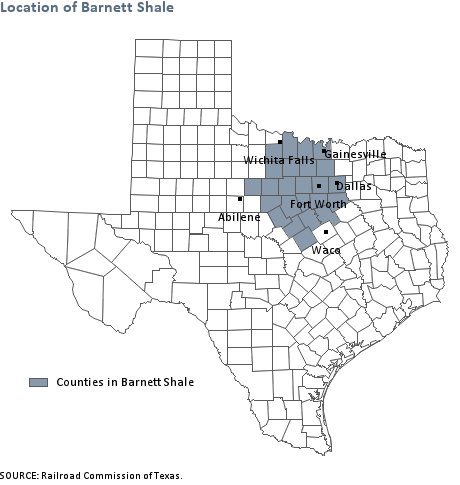
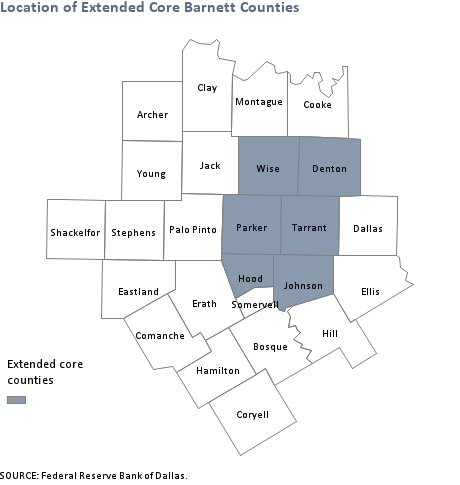
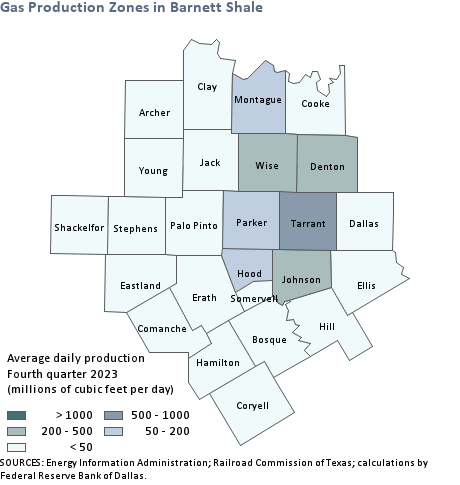

Geologists discovered the Barnett Shale Formation in the early 20th century, but drilling in the region did not begin until 1981.[1][2] This is when George Mitchell of Mitchell Energy began his nearly two-decade-long search for an economical way to remove gas from shale.
Conventional gas fields form over thousands of years, as gas seeps out of the source rock into reservoirs close to the surface (Figure 1).[3] Because this gas has already escaped from the source rock, it's easily accessible with a traditional vertical well.
In contrast, the gas in Barnett remains trapped in dense source rock over 1.5 miles below the earth's surface. To extract the gas, Mitchell Energy experimented with a process known as hydraulic fracturing. This involves pumping millions of gallons of water mixed with sand and chemicals into the shale. The pressure from the water causes the shale to fracture, and the sand keeps these newly formed cracks propped open, releasing the gas.
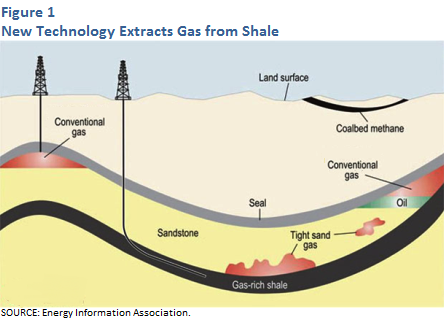
By the late 1990s, Mitchell Energy had made hydraulic fracturing cost-effective. This development paired with rising gas prices led to growing interest in the Barnett Shale. Applying another technological development in the early 2000s further bolstered development: horizontal drilling. Horizontal drilling can make a 90 degree turn in just a few hundred feet while traditional vertical wells can only go straight down from the well and traditional directional, or slant, drilling can take up to 2,000 feet to bend from a vertical to horizontal. Shale formations tend to be much longer than they are deep, so the combination of horizontal drilling and hydraulic fracturing creates more fractures in the shale, which allows more gas to escape. Since this technology was first used in Barnett in 2002, the number of wells in the area has skyrocketed (Chart 1).
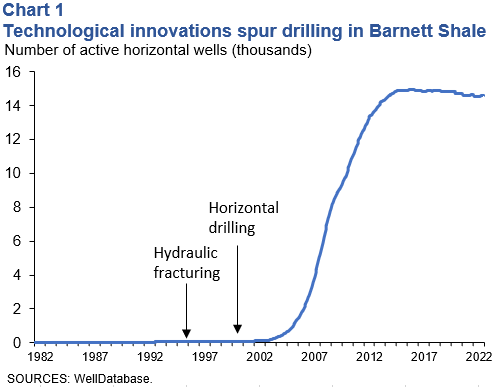
However, interest in the Barnett has waned over time and the area now sees little activity (Chart 2). This occurred for two reasons. First, there was a sharp decline in the price of natural gas after 2008. Second, operators have applied techniques learned in the Barnett in other basins, such as the Marcellus and Haynesville, and they found the economics of drilling in the Barnett to be less attractive than other gas basins.
Due to the sharp slowdown in activity, natural gas production in the Barnett has been in a slow but steady decline for more than a decade. Dry gas production peaked in late 2011 at slightly above 5 billion cubic feet per day and declined to slightly below 2 bcf/d today (Chart 3). Given a lack of investment in the basin, natural gas is likely to continue declining slowly but surely over the coming years.
With that said, the area still contains sizeable amounts of natural gas. A recent study by the Energy Information Administration estimates that Barnett still contains 13.6 trillion cubic feet of recoverable gas resources.[4] This is despite the fact that since Mitchell Energy drilled its first well in Wise County, Barnett Shale has already produced more than 23 trillion cubic feet of natural gas. However, a substantial sustained increase in the price of natural gas well above current levels would be needed to spark interest in further development of the Barnett Shale.
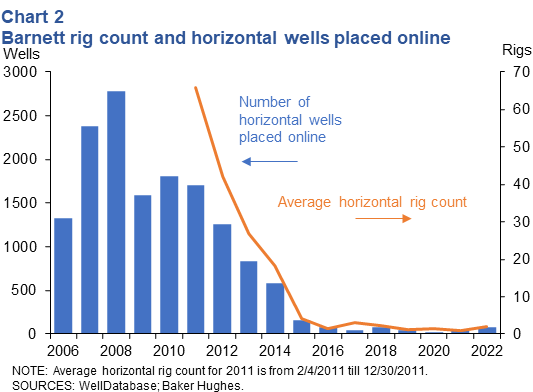
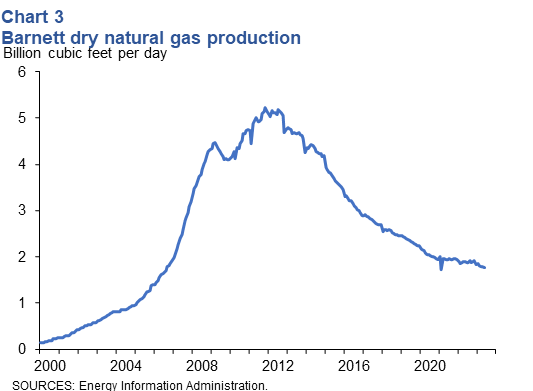
Notes
- Barnett Shale Information, Railroad Commission of Texas.
- A History and Overview of the Barnett Shale, Will Brackett, Powell Barnett Shale Newsletter.
- Natural Gas from Shale: Texas Revolution Goes Global, Southwest Economy, Third Quarter 2010.
- U.S. Crude Oil and Natural Gas Proved Reserves, Energy Information Administration.
| Highlights |
|---|
Natural gas production in Barnett Shale began increasing in the early 2000s. Production started to decline in 2012, but in December 2023, Barnett still accounted for 5.4 percent of Texas's natural gas production and 1.7 percent of the U.S.'s supply. |
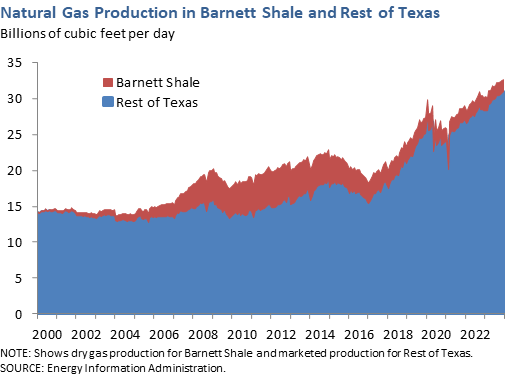
| Production December 2023 |
||
|---|---|---|
| Cubic feet per day (billions) |
Year/year change (percent) |
|
| Barnett Shale | 1.8 | –5.3 |
| Rest of Texas | 30.9 | 9.3 |
| SOURCE: Energy Information Administration. | ||
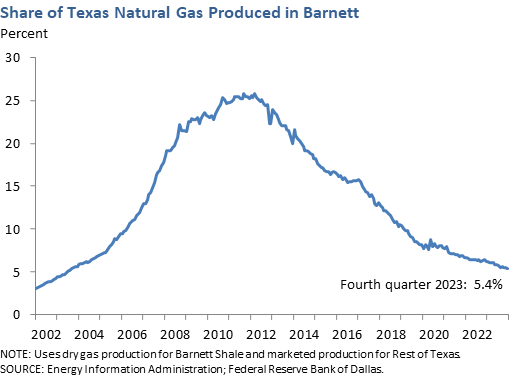
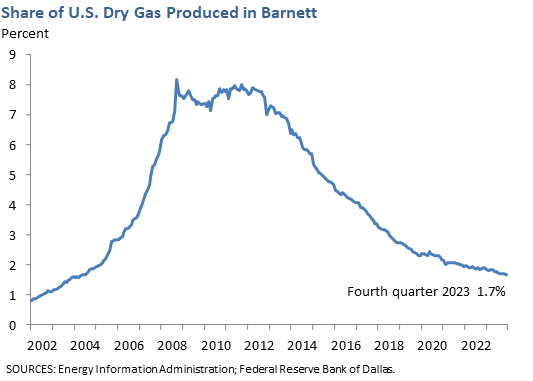
| Highlights |
|---|
The rig count in Barnett Shale has been declining since the start of 2011. The Barnett Shale used to attract a good number of rigs but since 2015 only a handful are active at any point in time in the area. |
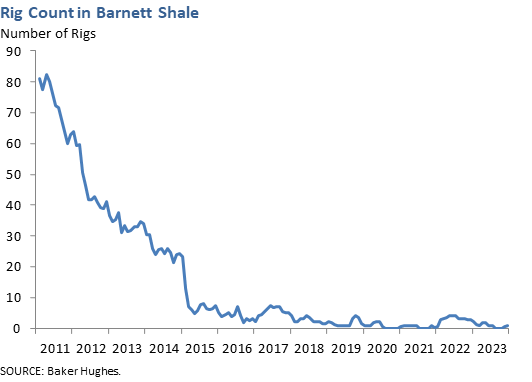
| Rig Count December 2023 |
||
|---|---|---|
| Number of rigs | Year/year change (rigs) |
|
| Barnett | 1 | -2 |
| SOURCE: Baker Hughes. | ||
- Energy Data Explanatory Notes and Resources
Describes the methodology used to compute production state-level and county-level production in the Barnett Shale. - Natural Gas from Shale: Texas Revolution Goes Global, Federal Reserve Bank of Dallas Southwest Economy, Third Quarter 2010. An article by Dallas Fed economists assesses the impact of technological innovations in Barnett.